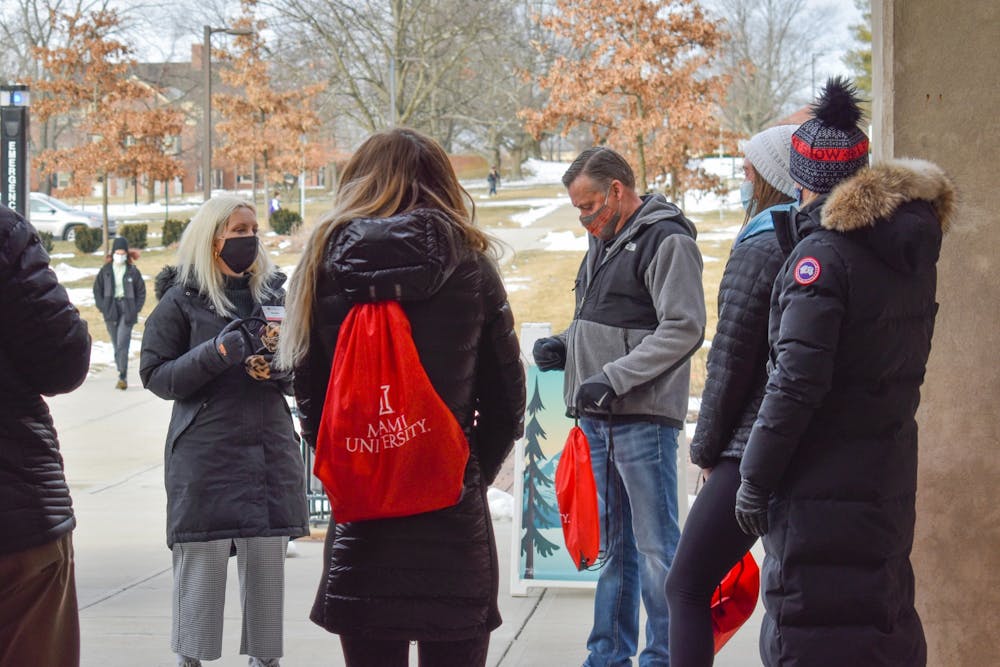In past years, the first step for high school seniors after being accepted to Miami University was scheduling a visit to campus during a Make it Miami event. Hundreds of soon-to-be first-years made the trip to Oxford and spent a day meeting faculty, listening to student panels and getting sore feet as they walked from building to building before deciding whether or not to commit.
This year, the first step is visiting the new Make it Miami website. On the front page is a picture of the Tri Delt Sundial with MacCracken Hall in the background.
“Welcome to Miami University!” the website reads. “Get ready to Make it Miami!”
Though it isn’t impossible for accepted students to tour campus this spring, it isn’t easy, either.
Andrew Boehm, Miami’s associate director for visits and events, explained that COVID-19 has made large scale events such as Make It Miami impossible, but tours and information sessions are still a go.
“All of our accepted students' events that are on campus are booking up very quickly,” Boehm said. “There’s none left in the entire month of February, and March is going to get packed up as well. People are coming to campus to visit.”
The auditorium where information sessions are held is cleared for up to 38 people to use at once, but Boehm said Miami chose to limit the number of students to 10 per time slot to accommodate one guest per student and to keep numbers low.
With the limited scope of in-person events available and the pandemic far worse than it was last spring when Miami first shut down, many accepted students may opt to stick with online events.
The Make It Miami website is designed to let students follow their own pace. Information is sorted into 10 categories, including one for each academic college. Each section has a calendar of live online events students can register for, from student panels to information sessions for specific majors.
Several live online events are dedicated to diversity, an issue Miami has historically struggled with. Miami’s undergraduate population across all campuses was 75% white as of last October, compared to a national average of 55.2% on college campuses.
Director of Admissions Bethany Perkins said the new online format for events such as Red Brick Roadshow and Make It Miami are making accepted students’ events more accessible to those who may not have been able to make it to campus regardless of COVID-19.
“There are the students who could always make it to campus, who had the financial resources or a way to get here,” Perkins said. “We now have provided access to faculty and staff and current students in ways that many students would not have had access to in the past if they had to get to campus to experience it.”
Enjoy what you're reading?
Signup for our newsletter
The accessibility of online resources is reflected in admissions statistics this year. While the pandemic caused freshman enrollment across the U.S. to decline by 13.1% last fall, Miami has processed about 30,300 applications for next year, a 9.7% increase from this time last year.
Included in the increased applications are 700 more applications from underrepresented students of color and 100 more applications from first-generation college students.
Miami went test-optional this year to account for the pandemic, meaning applicants were not required to submit standardized test scores. While Perkins said that may have led to increased applications from students who would have self-selected out in the past, the academic achievement of the Class of 2025 remains high. The average GPA among applicants is 3.8, slightly higher than in years past.
One area applications are notably lacking from, however, is international students.
“As we see a decline in students from out of the country, particularly in China, applying to the university, we then are filling those spaces and filling those gaps with more students from in state and from out of the state but in the U.S.,” Perkins said. “I’m in a position where I’m admitting more students from Ohio and from elsewhere in the U.S. to make up for the declines that we’re seeing internationally.”




